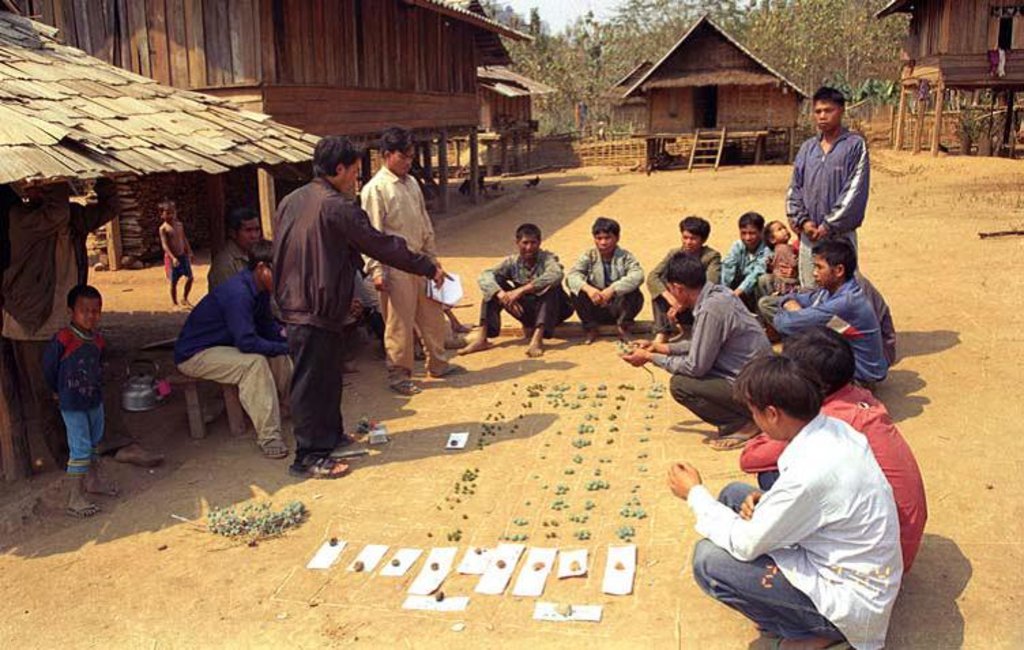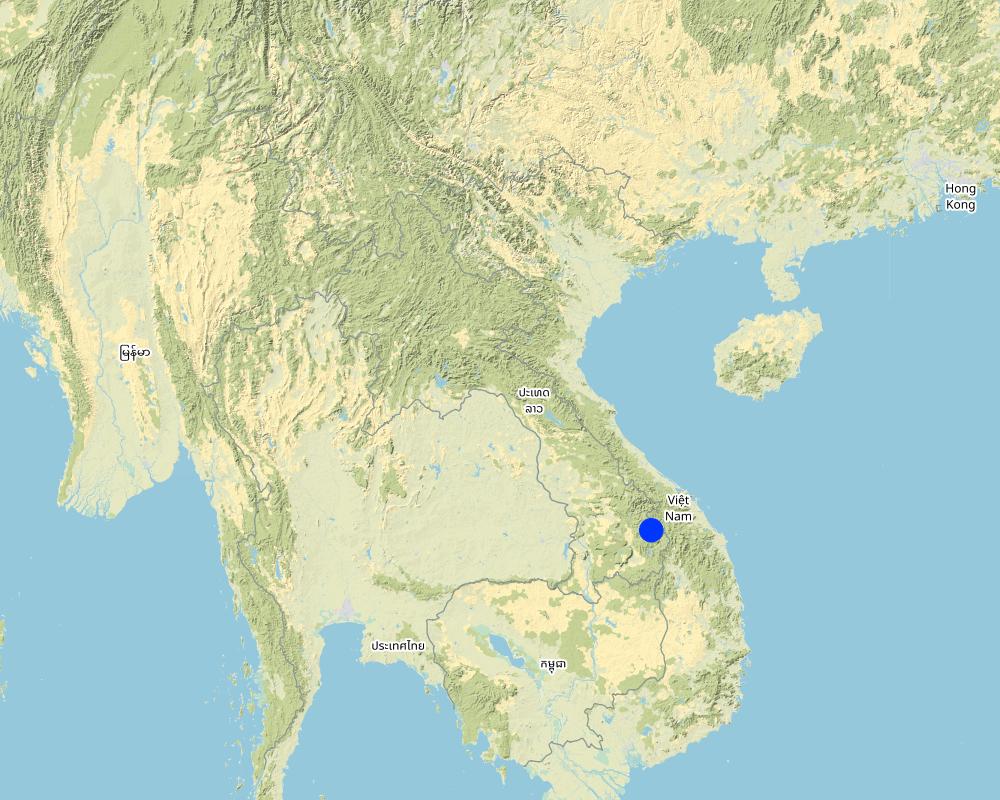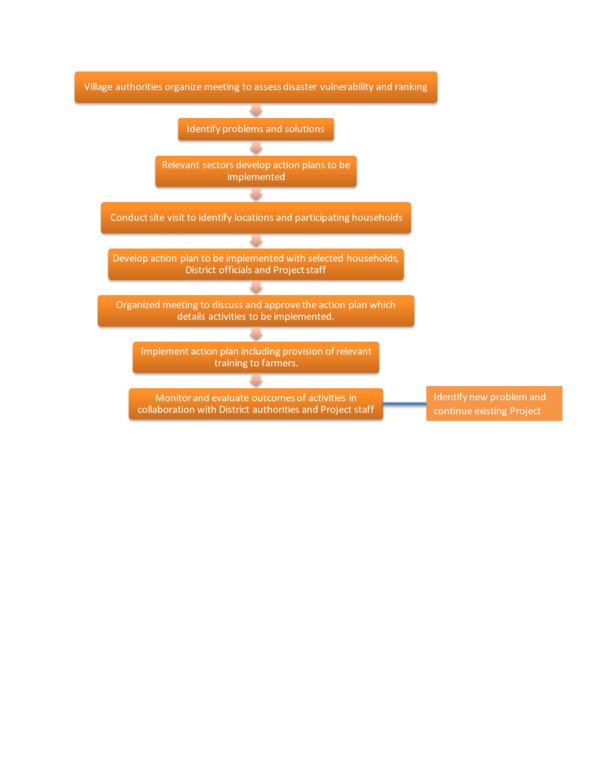Village Capacity and Vulnerability Assessment Project on Disaster Management [Lao People's Democratic Republic]
- Creation:
- Update:
- Compiler: Pasalath Khounsy
- Editors: Bounthanom Bouahom, viengsavanh phimphachanhvongsod, kang phanvongsa
- Reviewers: Nicole Harari, William Critchley, Joana Eichenberger
approaches_3877 - Lao People's Democratic Republic
View sections
Expand all Collapse all1. General information
1.2 Contact details of resource persons and institutions involved in the assessment and documentation of the Approach
Key resource person(s)
Project manager:
Phasaveng Phounsy
+856 030 211582
phounsy.phasaveng@careint.org
CARE Office in Saravan
Lao People's Democratic Republic
Name of project which facilitated the documentation/ evaluation of the Approach (if relevant)
Scaling-up SLM practices by smallholder farmers (IFAD)Name of the institution(s) which facilitated the documentation/ evaluation of the Approach (if relevant)
National Agriculture and Forestry Research Institute (NAFRI) - Lao People's Democratic Republic1.3 Conditions regarding the use of data documented through WOCAT
When were the data compiled (in the field)?
25/08/2017
The compiler and key resource person(s) accept the conditions regarding the use of data documented through WOCAT:
Yes
2. Description of the SLM Approach
2.1 Short description of the Approach
The project is aimed at capacity building in disaster emergency response at district and village levels. It has applied a participation approach in planning and implementation. This included the identification of problems, SWOT analyses, implementation, and monitoring.
2.2 Detailed description of the Approach
Detailed description of the Approach:
Since 2012, after the Ketsana typhoon hit the southern provinces of Lao PDR, CARE International in Xekong Province has initiatives that address disaster reduction which are funded through various sources. The project is aimed at capacity building in disaster emergency response at district and village levels. DarkCheung district, one of the poorest districts of Xekong province, has established a Disaster Management Unit in five villages. The project was supported by Luxembourg’s Ministry of Foreign Affairs, Debeco, through the European Union. Most of the projects were relatively small and short duration, with approximately 2-3 years of project implementation. In 2017, Care International has also followed up existing activities with support from Debeco which are implemented in the three districts of Kaleum, DarkCheung, and Lamam, covering 16 villages. The aspects of the work that are relevant to the district office of agriculture include Disaster Vulnerability Assessment and Village Capacity Building. The main objectives of the project are to increase capacity in disaster management within local communities; increase food security, gender equality promotion in cooperation with local authorities, and increase awareness about disaster prevention. In principle, the project applied a participatory approach in planning and implementation. This included the identification of problems, SWOT analyses, implementation, and monitoring. The village and district authorities, as well as farmers, have been actively involved in project activities. It should be noted that the district authorities played an active role in community development. However, challenges remain, as Care International in Xekong province developed only short term projects, and this may affect outcomes and continuity of objectives in the future.
2.3 Photos of the Approach
2.5 Country/ region/ locations where the Approach has been applied
Country:
Lao People's Democratic Republic
Region/ State/ Province:
Sekong Province
Further specification of location:
Kaluem, Darkchueng and Lamam district
Comments:
CARE International Office in Sekong province
Map
×2.6 Dates of initiation and termination of the Approach
Indicate year of initiation:
2014
If precise year is not known, indicate approximate date when the Approach was initiated:
less than 10 years ago (recently)
2.7 Type of Approach
- project/ programme based
2.8 Main aims/ objectives of the Approach
1. Strengthen capacity on disaster management at local levels;
2. Increase food security;
3. Promote gender equality amongst the local authorities; and
4. Increase awareness on disaster prevention.
2.9 Conditions enabling or hindering implementation of the Technology/ Technologies applied under the Approach
social/ cultural/ religious norms and values
- hindering
Unsafe birth, gender and other issues are sensitive and need careful approach and understanding.
availability/ access to financial resources and services
- hindering
institutional setting
- enabling
collaboration/ coordination of actors
- enabling
Good cooperation and participation in implementation of activities amongst the villagers
legal framework (land tenure, land and water use rights)
- enabling
policies
- enabling
land governance (decision-making, implementation and enforcement)
- enabling
knowledge about SLM, access to technical support
- enabling
Better coordination and understanding of district officials and village people.
markets (to purchase inputs, sell products) and prices
- hindering
workload, availability of manpower
- enabling
3. Participation and roles of stakeholders involved
3.1 Stakeholders involved in the Approach and their roles
- local land users/ local communities
Villagers or head of household participating in activities
Implementation, labour and material contribution as project needed
- community-based organizations
Village authorities
Provide socio-economic information, encourage villagers to participate in the project
- SLM specialists/ agricultural advisers
CARE International staff in Xekong Province
- NGO
CARE, Oxfam, Save the Children, French Redcross
- local government
Provincial, district coordinators and technical staffs
Facilitate the coordination and strengthening local authorities and communities
3.2 Involvement of local land users/ local communities in the different phases of the Approach
| Involvement of local land users/ local communities | Specify who was involved and describe activities | |
|---|---|---|
| initiation/ motivation | interactive | The village, district, provincial authorities, and project staff to identify and assess disaster vulnerability and ranking in communities. |
| planning | interactive | The village, district, provincial authorities, and project staff involved in problem analysis and identified solutions, conducted site visits in the project location with participating households. Develop action plan, organize meeting to discuss and approve project activities. |
| implementation | interactive | The village, district and provincial authorities in collaboration with project staff provided training and implemented project activities together with farmers in target villages. In case of significant activity such as infrastructure development, the project staff will assist in the implementation. |
| monitoring/ evaluation | interactive | All concerned stakeholders were involved in project monitoring in each phase. |
| interactive | Allow each stakeholders summarize project implementation outcomes, and discuss issues and identify solutions for future actions. |
3.3 Flow chart (if available)
3.4 Decision-making on the selection of SLM Technology/ Technologies
Specify who decided on the selection of the Technology/ Technologies to be implemented:
- all relevant actors, as part of a participatory approach
Specify on what basis decisions were made:
- evaluation of well-documented SLM knowledge (evidence-based decision-making)
- personal experience and opinions (undocumented)
4. Technical support, capacity building, and knowledge management
4.1 Capacity building/ training
Was training provided to land users/ other stakeholders?
Yes
Specify who was trained:
- land users
- field staff/ advisers
Form of training:
- on-the-job
- farmer-to-farmer
- public meetings
- courses
Subjects covered:
General knowledge on disaster prevention, disaster preparedness and emergency response, forest and environmental protection
4.2 Advisory service
Do land users have access to an advisory service?
Yes
Specify whether advisory service is provided:
- on land users' fields
Describe/ comments:
In addition, there were monitoring missions from village, district and provincial authorities. In case of an emergency situation, coordination was through mobile phones.
4.3 Institution strengthening (organizational development)
Have institutions been established or strengthened through the Approach?
- yes, moderately
Specify the level(s) at which institutions have been strengthened or established:
- local
Describe institution, roles and responsibilities, members, etc.
There were monitoring teams representing the village and district, and a village notice board.
Specify type of support:
- financial
- capacity building/ training
- equipment
4.4 Monitoring and evaluation
Is monitoring and evaluation part of the Approach?
Yes
Comments:
The CARE -Xekong M&E team collaborated with the through use of village notice boards in the village and district.
If yes, is this documentation intended to be used for monitoring and evaluation?
No
4.5 Research
Was research part of the Approach?
No
5. Financing and external material support
5.1 Annual budget for the SLM component of the Approach
If precise annual budget is not known, indicate range:
- 100,000-1,000,000
Comments (e.g. main sources of funding/ major donors):
Multiple funding sources including Debego for humanitarian aid, European Union (EU), Ministry of Foreign Affairs of Luxembourg
5.2 Financial/ material support provided to land users
Did land users receive financial/ material support for implementing the Technology/ Technologies?
No
5.3 Subsidies for specific inputs (including labour)
- labour
| To which extent | Specify subsidies |
|---|---|
| fully financed |
If labour by land users was a substantial input, was it:
- voluntary
Comments:
Project provided lunch and villagers shared labour
5.4 Credit
Was credit provided under the Approach for SLM activities?
No
5.5 Other incentives or instruments
Were other incentives or instruments used to promote implementation of SLM Technologies?
No
6. Impact analysis and concluding statements
6.1 Impacts of the Approach
Did the Approach empower local land users, improve stakeholder participation?
- No
- Yes, little
- Yes, moderately
- Yes, greatly
The project has strengthened local communities to work together from planning, implementing, and monitoring approaches.
Did the Approach help land users to implement and maintain SLM Technologies?
- No
- Yes, little
- Yes, moderately
- Yes, greatly
Did the Approach improve coordination and cost-effective implementation of SLM?
- No
- Yes, little
- Yes, moderately
- Yes, greatly
Did the Approach mobilize/ improve access to financial resources for SLM implementation?
- No
- Yes, little
- Yes, moderately
- Yes, greatly
Did the Approach improve knowledge and capacities of land users to implement SLM?
- No
- Yes, little
- Yes, moderately
- Yes, greatly
Did the Approach improve knowledge and capacities of other stakeholders?
- No
- Yes, little
- Yes, moderately
- Yes, greatly
Did the Approach build/ strengthen institutions, collaboration between stakeholders?
- No
- Yes, little
- Yes, moderately
- Yes, greatly
Did the Approach mitigate conflicts?
- No
- Yes, little
- Yes, moderately
- Yes, greatly
Did the Approach empower socially and economically disadvantaged groups?
- No
- Yes, little
- Yes, moderately
- Yes, greatly
The project has assisted the disabled groups, divorced women with many children, households with lack of productive labours who were all prioritized as project beneficiaries.
Did the Approach improve gender equality and empower women and girls?
- No
- Yes, little
- Yes, moderately
- Yes, greatly
The project has increased awareness on women’s rights.
Did the Approach encourage young people/ the next generation of land users to engage in SLM?
- No
- Yes, little
- Yes, moderately
- Yes, greatly
Did the Approach improve issues of land tenure/ user rights that hindered implementation of SLM Technologies?
- No
- Yes, little
- Yes, moderately
- Yes, greatly
Did the Approach lead to improved food security/ improved nutrition?
- No
- Yes, little
- Yes, moderately
- Yes, greatly
Did the Approach improve access to markets?
- No
- Yes, little
- Yes, moderately
- Yes, greatly
The project activities are linked to food security.
Did the Approach lead to improved access to water and sanitation?
- No
- Yes, little
- Yes, moderately
- Yes, greatly
After the Ketsana typhoon, the project has supported the repair of 3 – 4 gravity fed water supply systems in 16 villages.
Did the Approach lead to more sustainable use/ sources of energy?
- No
- Yes, little
- Yes, moderately
- Yes, greatly
The project has suggested the use of solar voltage power systems in areas without connection to main power grids in 10 villages in Kaleum and DarkCheung district
Did the Approach improve the capacity of the land users to adapt to climate changes/ extremes and mitigate climate related disasters?
- No
- Yes, little
- Yes, moderately
- Yes, greatly
Did the Approach lead to employment, income opportunities?
- No
- Yes, little
- Yes, moderately
- Yes, greatly
6.2 Main motivation of land users to implement SLM
- reduced land degradation
- reduced risk of disasters
- environmental consciousness
- enhanced SLM knowledge and skills
6.3 Sustainability of Approach activities
Can the land users sustain what has been implemented through the Approach (without external support)?
- yes
If yes, describe how:
The district and village authorities have some basic understanding about disaster responses.
6.4 Strengths/ advantages of the Approach
| Strengths/ advantages/ opportunities in the land user’s view |
|---|
| Strengthening capacity of village, district and provincial authorities (Committees for Disaster Prevention and Control) particularly after Ketsana typhoon. |
| Communities gain knowledge and are able to identify problem and develop action plans on disaster management. |
| The project has implemented activities that provided benefits to the public such as: disaster warning, rainwater storage, precipitation station. |
| Supported high frequency radio system instead of mobile phones. |
| Strengths/ advantages/ opportunities in the compiler’s or other key resource person’s view |
|---|
| Disaster management is an important aspect that needs to be implemented in all regions. |
| Local communities and other stakeholders were actively participated in the project. |
| The project helped to identify key problems and strengthen capacity to ensure regular and continuous monitoring of activities although it had only one-year lifespan. The project adopted M&E framework from similar projects in order to effectively monitoring this project. |
6.5 Weaknesses/ disadvantages of the Approach and ways of overcoming them
| Weaknesses/ disadvantages/ risks in the land user’s view | How can they be overcome? |
|---|---|
| The disaster management projects had short term lifespan but there were considerable needs and expectations from communities, and the lack of sufficient funding. | |
| The MOU signing process for disaster related projects took long time between the government and NGOs which caused delayed in project implementation. | The need to have better coordination on the review and approve the MOU document between the two parties. |
| Weaknesses/ disadvantages/ risks in the compiler’s or other key resource person’s view | How can they be overcome? |
|---|---|
| The GOL has yet identified vulnerable areas to certain disasters and there are still a lack of funding allocation to meeting the needs. | The need to identify appropriate vulnerable areas including high vulnerability, warning areas and among others. |
| Most projects were managed by non-profit organizations and typically have short-term lifespan and limited staff. | The need to develop long-term planning with multi-funding organizations. |
7. References and links
7.1 Methods/ sources of information
- interviews with SLM specialists/ experts
2
Links and modules
Expand all Collapse allLinks
No links
Modules
No modules





